Introduction
Wind energy has become one of the popular sources of renewable energy in modern society. According to Martin et al. (2016), climate change and global warming are factors that the global society can no longer ignore. The effect of greenhouse gases on the environment is widely documented and stakeholders are keen on reversing the trend. As such, there is a need to reduce consumption of fossil fuel. Myhr et al. (2014) argue that the negative impact that fossil fuel has on the environment is not the only problem associated with using petroleum products.
Fluctuation of prices in the international market is another major concern that needs to be addressed. The increasing popularity of renewable sources of energy and advanced technology in this field has offered hope. In developed nations such as the United States, the United Kingdom, Germany, Canada, Japan and China technological advancements have made it possible to harness wind energy to be used in the industrial sector and for domestic purposes. Offshore wind energy is one of the concepts, which are gaining rapid relevance in renewable energy production.
Construction of offshore wind turbines is significantly different from that which is constructed on the land. The technology needed, the complexity of structures and maintenance required when developing offshore wind project are unique. The environmental management system in the construction of these projects must be given priority. As Lecca et al. (2017) note, one of the principal goals of renewable energy sources is to protect the environment.
Construction of offshore wind turbines involves direct interference with the aquatic environment. The concept of sustainable construction in such a project is paramount. On the one hand, there is a need to produce clean energy that has minimal impact on the environment. On the other hand, it is necessary to ensure that the built environment of such projects does not interfere with the natural habitat of aquatic animals. In this project, the focus is on providing an in-depth analysis of offshore wind energy production.
Meaningful Subset of the Renewable Energy Source
The need to reduce the consumption of fossil fuel in the modern global society is becoming evident, especially in urban centres. In China, major cities such as Beijing and Shanghai have very high levels of toxic substances in the air that sometimes the elderly and young children are forced to remain indoors at certain hours of the day for health reasons (Chaouachi, Covriga & Ardelean 2017). These cities emit huge amounts of greenhouse gases that do not only affect the environment but also the people.
In the past, the political class and business executives rejected the idea that climate change is a reality and is caused by massive pollution by the industrial sector. However, the reality of climate change cannot be ignored further. Cyclones, wildfires, flooding and prolonged drought are common realities claiming lives of many people across the world. The impact of climate change is not just felt in the developing nations but in developed countries as well.
In the United Arab Emirates, the government has come to appreciate the reality of climate change and measures have already been taken to find possible solutions (González-Aparicio et al. 2017). Solar energy is one of the renewable energy sources that have become popular in this country because of the regular sunlight throughout the year. However, domestic and industrial energy needs cannot be met with solar energy alone. Wind energy is the other viable alternative that can be considered.
One of the biggest challenges that stakeholders often face in the construction of wind power plants is the limited land space. As the population continues to increase, land space available for such expansive projects continues to diminish. Dedecca, Hakvoort and Ortt, (2016) explain that technology has made it possible to use sea space to construct wind turbines. Sustainable design of the built environment in this sector of renewable energy not only focuses on how to ensure that these offshore wind energy projects are functional but also environmentally friendly. The United Arab Emirates and regional countries such as Oman, Saudi Arabia and Jordan can borrow from countries, which have successfully embraced this approach of producing wind energy. Figure 1 below shows global offshore wind projects in North America, Europe and parts of Asia.
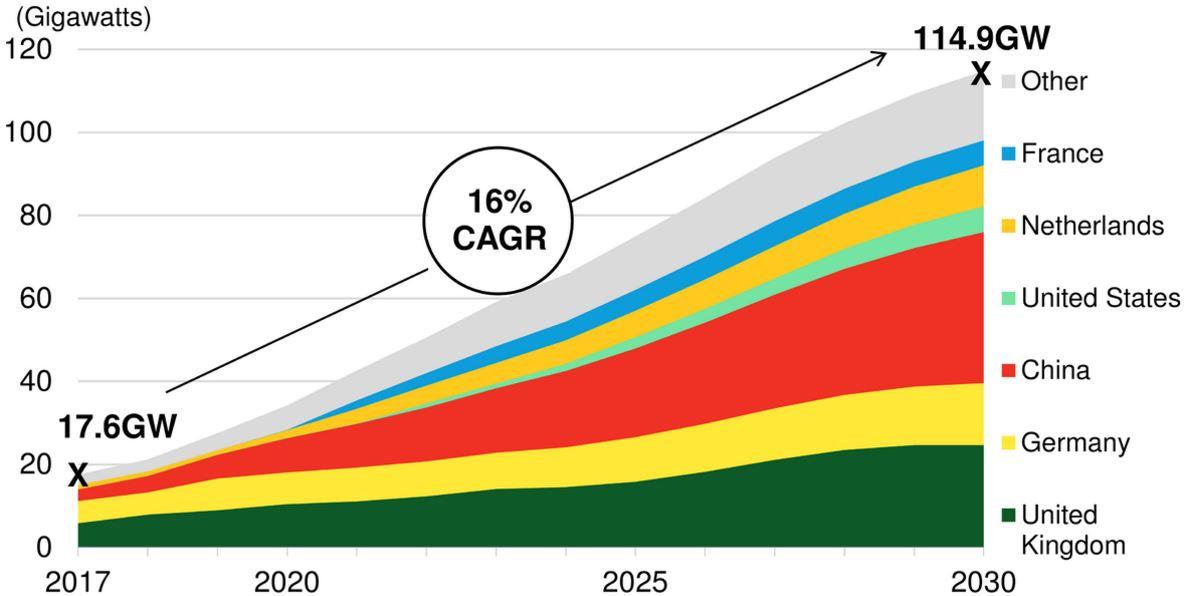
Current State of Technological Development of Offshore Wind Energy
Technology in the offshore wind energy is evolving rapidly as new concepts continue to emerge. According to Lacal-Aránteguia, Yusta and Domínguez-Navarro (2018), initial offshore wind turbines had to be strongly anchored on the seabed using strong concrete or special metallic posts. Most of the offshore wind turbines around the world still use this concept of the foundation. It is simple to develop although it uses a significantly high amount of construction materials.
It also has a more significant impact on the aquatic environment. When analysing the current state of technological development of this source, it is necessary to analyse steps that have been taken from the initial type of the offshore wind energy project to the current state. The following are some of the types of traditional foundations in offshore wind energy production.
Monopole Foundations
This form of foundation is considered a traditional approach to anchoring the offshore wind turbines because it was one of the initial concepts. It uses steel tubes with diameters that range from 4-6 meters to construction the foundation (Beinke, Alla & Freitag 2017). As the name suggests, it uses a single pole of depth below 30 m. to support the offshore wind turbine. The steel structure is driven into the seabed to anchor the turbine. Monopole foundations are often constructed a few meters from the shores, especially in shallow waters. Sperstad et al. (2017) explain that it is the most common type of foundation in offshore wind projects because it is less costly compared with other projects and it simple to construct.
However, the main weakness is that it is relatively weak and cannot support large wind turbines. They can also be destroyed by turbulence at the sea with ease compared with other forms of foundation. It is limited in terms of the depth of the sea and distance from the shore. As such, it may not be the most appropriate foundation for large offshore wind projects where large turbines have to be used. The following figure 2 shows a monopole foundation.
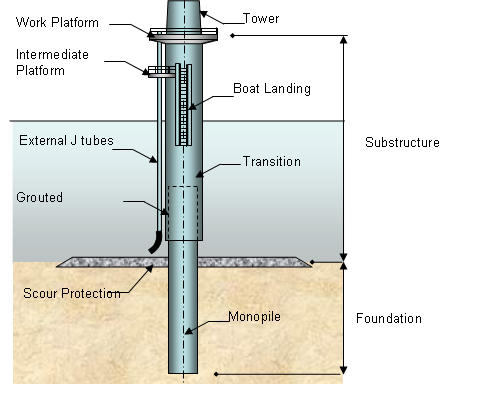
Tripod Foundation
A tripod foundation was designed to overcome the weaknesses of the monopole foundation. It is popularly used in water depths ranging from 30 to 60 meters (Topham & McMillan 2017). The tripod, as the name suggests, uses three main steel tubes, which are inserted into the seabed, just like the monopole foundation (Ioannoua, Angusb & Brennan 2018). The foundation is weightier and longer than the monopoles. It means that it can be used in deep waters several kilometres from the shore. It is strong and can withstand great forces of the sea. It is suitable for large offshore wind projects.
However, it also has weaknesses that cannot be ignored. One of the main issues of the tripod foundation is that the project is costly, takes time to be completed and requires a highly skilled workforce. It was a technological advancement to introduce the tripod foundations. It emerged out of the desire to increase the energy output of the offshore wind projects and increase their stability. It also has a greater impact on the environment compared with the monopoles. Figure 3 below shows a tripod foundation.
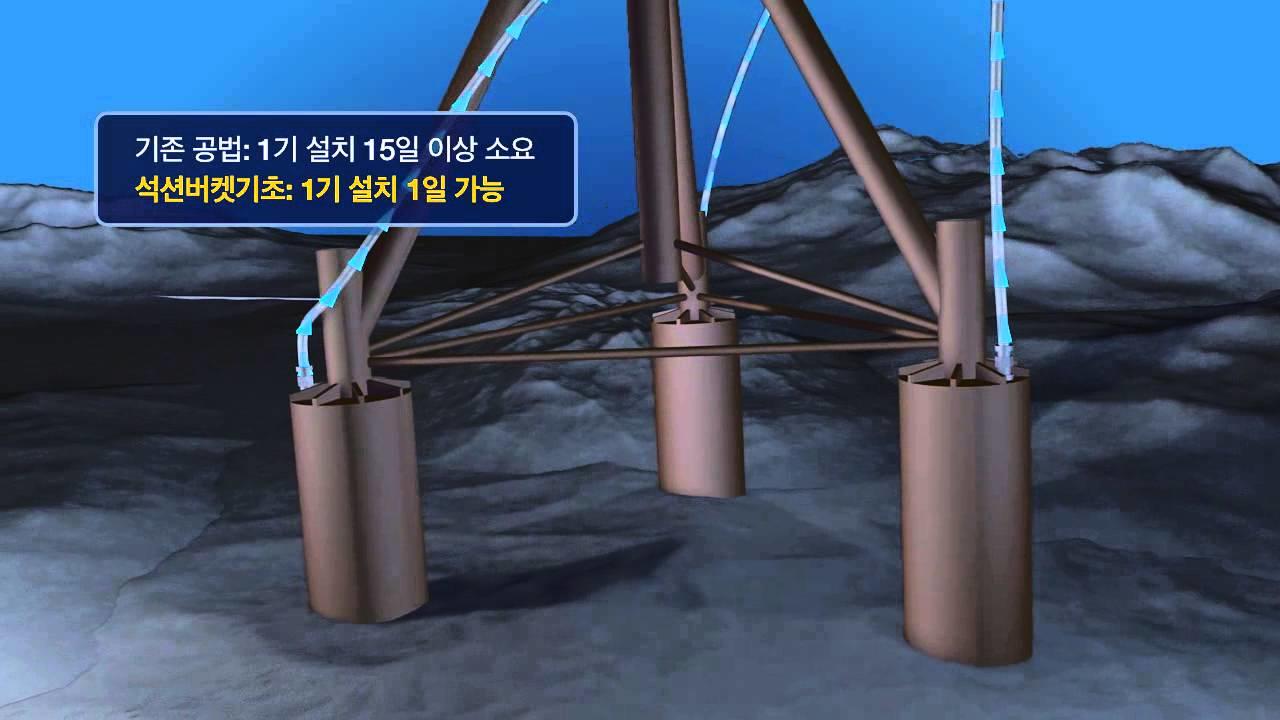
Gravity-Based Structures
The foundation is popular in shallow waters when planning to install heavy wind turbines. Gintautas, Sørensen and Vatne (2016) observe that its construction may require dry docks to facilitate its construction. It is common in cases where the project has access to dry docks that can facilitate concrete construction in cases where pile structures cannot be used. It has a high capacity in terms of the weight it can support, but the cost of installing the entire system can be prohibitive (Paterson et al. 2018). This form of foundation is common in Europe and parts of North America. Figure 4 below shows the gravity-based foundation.
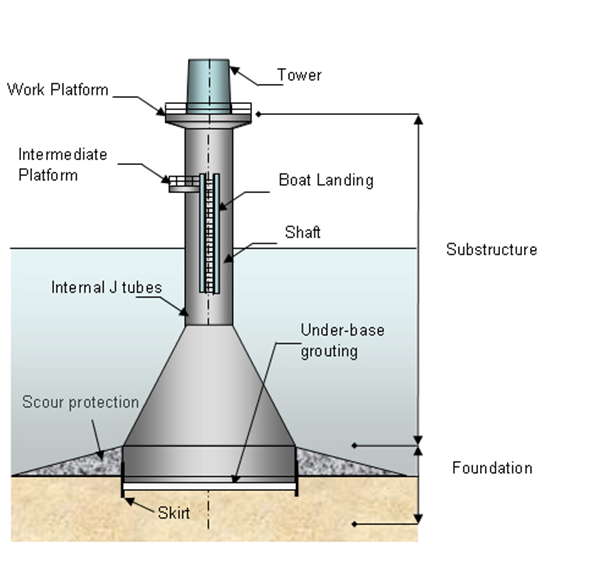
Floating Structures
Shallow-sea wind energy structures have several limitations, as Poulsena and Lema (2017) observe. Most of the coastal lines are popularly used as beaches where tourists and locals can have a good time. Construction of these structures in the shallow waters a few kilometres from the shore would create a conflict of interest with other sectors of the economy, especially the tourism industry.
Various countries in MENA region have focused on producing and consuming renewable energy (Ahn et al. 2017). As such, it becomes necessary to have these projects conducted deep within the sea, several miles away from the coastal line popular among tourists. The problem is that the concept used in developing foundations discussed above cannot be applicable in the deep seas where the depth may be from 200 to 700 meters below the water surface. Floating structures offer a solution to this challenge.
Instead of using concrete or steel poles to anchor the turbines, this concept uses floating structures. When using this concept, a steel floater that has ballast, which extends about 100 meters below the surface of water is used as a foundation (Vis & Ursavas 2016). Three anchor wires are then used to support the foundation to the seabed to ensure that it does move. The anchor wires can go as deep as 700 meters, making this foundation appropriate for deep-sea offshore wind energy production.
The concept has gained massive popularity in the United States and China where coastal lines are popular with tourists. It makes it possible to produce wind energy deep in the ocean without affecting other economic activities. It facilitates massive wind energy projects because the foundations can support large turbines. However, Lu and Zhou (2018) admit that it also has its weaknesses.
Constructing the foundations costs more compared with those discussed. It also requires advanced technology to construct the floaters and to anchor them deep in the sea. Such projects also have a significant impact on the aquatic lives. It may require advanced technology to ensure that electricity that is transported using large cables to do not pose any significant effect on aquatic animals. The electromagnetic waves, which are often emitted by these large cables, should be managed in a manner that would ensure the safety of animals in the seabed. There is also the need to ensure that these large floating structures do not pose any threat to sea vessels. They should not block the known paths of ships. Figure 5 below shows the image of the floating structures.
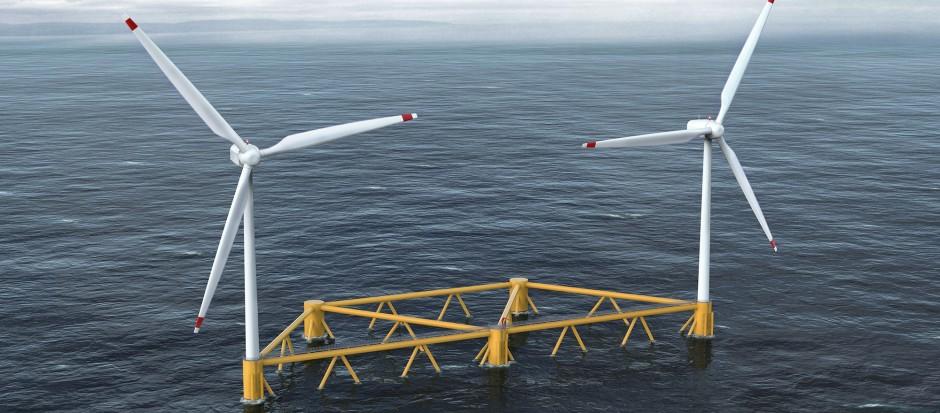
Offshore Turbine
Technological advancement has been witnessed in both the foundation and in the turbine design used in offshore wind energy production. According to Rusu and Venugopal (2019), the strength of wind in the deep-sea is stronger than it is on land. Obstacles on land such as buildings, trees and even hills tend to slow down the speed of wind. Such obstacles do not exist in high seas. As such, wind turbines used on land may not be appropriate for offshore wind energy production.
General Electric has come up with a special design of offshore wind turbines known as GE’s Haliade-X that can withstand the extreme forces in the high seas and produce as much energy as possible. With a length of 218.2-meter rotor diameter, this turbine has a capacity of producing 14 MW of wind energy. The blade length of this model is 107 meters while its weight is 55 tonnes.
With a cut-out wind speed of 28 m/s, cut-in wind speed of 3.5 m/s, a rated rotor speed of 7.81 RPM (revolutions per minute) and a rated tip speed of 89.2 m/s, this model is one of the most efficient wind turbines in the market (Wu & Sun 2018). It is particularly effective in the deep-sea where wind speed is high. Technology has also evolved in terms of the cables used to transmit the energy from the sea to the shore and then to the national grid.
Anaya-Lara et al. (2018) explain that stakeholders were concerned about the strong electromagnetic radiation emitted by the undersea cables used to transmit the energy. New advanced cables with special insulations have been developed to help make it safe for sea creatures that may be exposed to these cables. The primary goal of these projects is to ensure that in an attempt to produce environmentally friendly energy aquatic environment is not affected negatively.
Potential Future Developments of Offshore Wind Energy
Offshore wind energy has a huge potential that is yet to be fully tapped even among the developed nations. While solar energy may not be reliable during winter in some parts of the world, offshore wind-energy has exponential potential if it can be tapped in an appropriate way. Heier (2014) explains that one of the main challenges that stakeholders currently face is how to construct offshore wind turbines without affecting the ecosystem and interfering with other economic activities such as fishing and transportation. Lu and Zhou (2018) explain that some countries are developing new designs for these structures to ensure that they do not interfere with the movement of sea vessels.
Figure 6 below shows a design where the turbines are constructed in a linear form to ensure that shipping boats can easily manoeuvre their vessels with ease. It means that fishing in these areas will not be affected. When constructing these energy production plants, Bhattacharya (2019) explains that care should be taken to avoid common paths of large ships. The high waves produced by large transport ships may have a serious impact on these vessels.
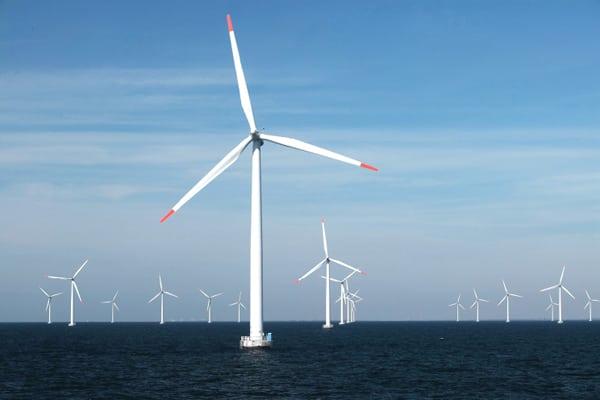
Pollution is another factor that must be considered as stakeholders focus on the future development of this source of energy. During the process of construction, some of the materials used may pollute the environment. Heier (2014) explains that new technologies should be developed to ensure that pollutants are not released into the sea. During the process of maintaining and replacing the system, oil is often used to protect the rotating parts of wind turbines. The problem is that oil has a devastating effect on aquatic life. It forms a blanket on the water surface that limits the free flow of oxygen needed by aquatic animals. It is also poisonous to these animals. Measures should be taken to address these challenges as offshore wind energy continues to become popular.
Main Advantages, Disadvantages and Limitations of Offshore Wind Energy
Offshore wind energy is currently one of the popular renewable energy sources in both developed and developing economies. It is important to understand the main advantages, disadvantages and limitations of offshore wind energy. The analysis will help to understand weaknesses that need to be addressed to improve the efficiency and effectiveness of this energy source while at the same time taking full advantage of the potentials presented by this energy source.
Advantages
Production of clean energy for domestic and commercial use is one of the main benefits of offshore wind energy production. According to Karimirad, Michailides and Nematbakhsh (2018), the global community is becoming sensitive towards the need to protect the environment. The use of petroleum products as a source of energy is becoming less popular within the region. The massive pollution caused by fossil fuel has made it necessary for the government and other stakeholders to consider alternative sources of energy with minimal impact on the environment.
Offshore wind energy is popular because of its impact on the environment. It is easy for the government to support such projects because they are viewed to be part of the country’s Vision 2030. Successful production of sufficient wind energy means that the country will rely less on petroleum products as a source of energy.
Offshore wind energy has numerous benefits, one of which is its limitless availability. Offshore wind energy has exponential potential if proper mechanisms can be embraced to facilitate its exploitation. The strength of wind energy offshore is stronger than it is on land. The expansive sea also helps to address the problem of limited land space that hindered its exploitation in the past (Lu & Zhou 2018). If the global society can make a significant investment into offshore wind energy, it would be possible to reduce reliance on non-renewable energy sources such as oil and gas. It will be possible to produce enough energy for both commercial and domestic use within the country.
Potential of scaling-up is another benefit of the offshore wind energy project. The emergence of floating structures used in anchoring wind turbines and the new design of planting these structures means that it is possible to increase the number of turbines in the sea to meet emerging demands. The firm assigned to undertake such a project would not have to worry about the land space needed to scale up the project. The only factor that should be considered is the need to avoid waterways for large ships and to avoid beaches used by the tourism industry. Emerging technologies in this field are also lowering the cost of installing offshore wind turbines. Such developments will make it easy for the country to scale up production of wind energy.
Reliability is another major factor that must be considered when focusing on the production of renewable energy. Heier (2014) explains that the industrial sector requires consistent availability of energy every day throughout the year to ensure that their production processes do not stop. Hydroelectric power in the country is not reliable because of the limited number of rivers that can be used for its production (Bhattacharya 2019).
In most of the cases, the government is forced to use fossil fuel in the production of electrical energy needed by both industrial and domestic use. On-land wind turbines are also less reliable, especially when there is calm. However, offshore wind energy has the potential to produce energy at all times. Even when the weather is calm, the movement of wind in the high seas is always high, which means that there will be a consistent production of energy at all times. This form of energy may help to reduce the country’s reliance on fossil fuel to produce electrical energy needed in various sectors of the economy.
Creation of job opportunities is another advantage of having offshore wind energy plants. According to Lu and Zhou (2018), construction of offshore wind energy, production plants require both skilled and semi-skilled labour. Skilled workers such as architects, quantity surveyors and engineers are responsible for designing the construction plan, determining the cost of the project and the resources will be spent and in the actual implementation of the plan.
Semi-skilled labour will be needed at the construction sites to help with the lifting and operating the machines at the construction sites. Expatriates will also have the opportunity to work in a given country. Bhattacharya (2019) argues that one of the benefits of the expatriates is that they often spend in the country, which boosts economic growth. They also promote local tourism when they invite their family members to visit them.
Disadvantages and Limitations
Offshore wind energy production offers this country the opportunity to lower the consumption of fossil fuel. Despite the benefits discussed above, it is important to admit that challenges exist should be addressed by relevant stakeholders. Environmental impact of these projects is one of the major causes of concern. According to Bhattacharya (2019), construction of this offshore wind energy, production platforms affects the ecosystem of the sea.
When concrete pillars are constructed in the sea, aquatic life will be affected significantly. Some of these sea creates are often killed during the construction process while others have to move away from the site and change their habitat to ensure that they are safe. The release into the sea of oil used to lubricate the engines poses serious challenges to the aquatic life even if it is in small quantity.
Transportation challenges pose a serious limitation in offshore wind energy projects in the country. The design used in the construction of offshore wind-energy production plants has evolved, but transportation of the produced energy remains to be a major challenge. In an attempt to increase the amount of energy from such projects and to ensure that other economic activities are not affected, designers often recommend that these plants should be constructed several kilometres from the shore.
The longer the distance from the land, the more challenging it becomes to transport the energy to the national grid. Overhead cables cannot be used to connect the plant to the grid. Undersea cables are considered more appropriate. However, Heier (2014) notes that a significant amount of energy is lost when such cables are used. The longer the cables used on the seabed, the more the amount of energy that would be lost during the transportation phase.
Installation of these plants also poses numerous challenges. Bhattacharya (2019) explains that such projects are always risky, especially at the initial stages of construction. Drowning is a serious threat that the team involved must be aware of during the entire process of construction. Falling of parts of the structure or different metals used in constructing the plant may cause death or serious injury to the team involved in the construction process.
Heier (2014) argues that other than occupational risks, the actual process of constructing these plants is complex. It requires precision to ensure that the floating structures are placed at the right angle and that they are of the right weight to ensure that they remain afloat. The experts must also consider the impact that water will have on the system within a given period. A minor mistake may have devastating consequences on the entire project.
The lower specific power-rotor design challenge is another issue that stakeholders in this industry are keen on addressing. It is necessary to have turbines capable of producing large amounts of energy even when the wind speed is low. Reliability of this renewable source depends on its capacity to continue producing energy despite any changes that may exist on weather conditions. It means that the power rotor should be designed in a way that it can be propelled even by the slightest of wind speed. General Electric came up with Haliade-X as a way of addressing this limitation (Wu & Sun 2018). However, it is still necessary to find ways of improving the efficiency of this system to increase energy production.
Competing uses cannot be ignored. Sustainable design of the built environment in the high seas is more popular in oil production than it is in wind energy production. The design and construction approach used in the development of offshore wind energy plants share a lot in common with the construction of oilrigs. Heier (2014) argues that oil is still one of the most profitable products in the global market.
It is more economically viable for the country and other stakeholders involved spending resources on the production of offshore oil than it is to produce offshore wind energy. Businesspersons and the government are more likely to spend more resources on initiatives that promise great returns. It means that investment needed for wind energy production can be diverted to oil production to help in the country’s economic growth.
Regulatory policy is another concern that may limit the production of offshore wind energy. Every government would be keen on ensuring that policies regulating offshore wind energy production protect other industries, especially tourism. In Europe and North America, such projects are often undertaken in deep seas where they cannot affect local tourist and port activities. China and Japan are also strict when it comes to defining the location for such projects (Poulsena & Lema 2017). It means that the government cannot approve the construction of offshore wind energy plants if it is believed that such initiatives would have a negative impact on local ports’ activities.
The tourism industry also plays a major role in boosting the economy of this country. As such, it would not be easy for the government to approve projects believed to have a significant impact on this industry. It means that players in this industry should be ready to find ways of aligning their projects with other major economic activities in the country to ensure that they not only get approvals but also the financial support needed.
Future Challenges in Developing Offshore Wind Energy
Offshore wind energy has huge potentials. The MENA region has come out strongly to support production and use of renewable energy sources. As the production of hydroelectric energy continue to become less reliable and fossil fuel less desirable, the renewable energy source is the only options that the country should focus on in the future. However, the future of this industry depends on the ability of stakeholders to address challenges that it is currently facing. It is important to look at these challenges and define ways of overcoming them.
Extreme weather conditions pose a serious challenge in the development of offshore wind energy. The Arabian Peninsula is not always susceptible to tropical cyclones because of the dry air that comes from the Arabian Desert and the disruptive wind shear that is generated by the monsoon (Lu & Zhou 2018). These natural forces have made coastal regions in the Middle East relatively safe compared with that of other parts of the world. However, climate change and global warming may have a significant impact on these weather patterns and soon coastal regions in the Arabian Peninsula may be hit by cyclones.
From May 21 to May 27, 2018, the Arabian Peninsula was for the first time hit by Cyclone Mekunu of category 3 (Bhattacharya 2019). Properties worth billions of dollars were destroyed by the resulting storm. Figure 7 below shows the region affected by Cyclone Mekunu on different dates. The incident was a rare occurrence that demonstrates that this region may suffer from worse cyclone strikes in the future. Such destructive winds may be a challenge to the development of offshore wind energy plants in this country. It might not be easy to protect the plants from a possible strike by such strong winds in the high seas. The cost of reconstruction after every storm may be too high to be sustainable.
Innovation in building materials technology might be the solution to the problem discussed above. Emerging technologies can help to define how to construct these power plants in a way that can withstand strong forces in the wind. Bhattacharya (2019) believes that new technology should be developed that can help to submerge the turbines to the base of the shaft at the foundation when it is predicted that a cyclone would strike. The strategy reduces resistance that the shaft above the water would have on the storm. It lowers the level of destruction of the turbines. Reuse and recycle should also be encouraged as a way of dealing with the problem.
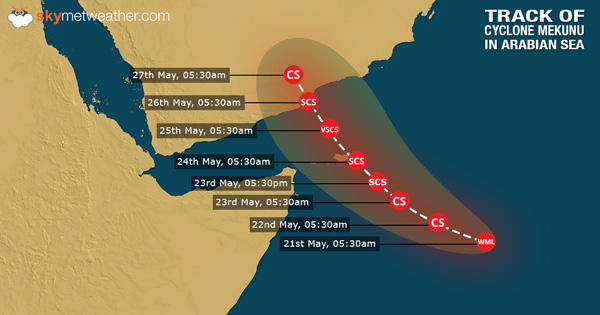
Energy policy, politics and regulations are possible future challenges in developing offshore wind energy in the country. The high cost of construction and the unpredictable returns have made offshore wind energy production less lucrative to the business community (Lu & Zhou 2018). It is less likely that private players would want to invest their money in such projects unless they are given incentives by the government. It means that energy policies that the country embraces have a direct impact on the ability of this industry to achieve growth. When the political class realise the importance of this industry and injects into it the needed resources, then the expected growth will be witnessed.
When government policies and regulations put in place favour the production of fossil fuel at the expense of renewable energy sources, it may not be easy to realise the expected development. Bhattacharya (2019) explains that in Germany, the production of wind energy has been fluctuating. In 2014, it was one of the leading producers and consumers of wind energy. However, it has been overtaken by the United Kingdom, China and the United States because of the policies put in place by the government. If these projects are not given priority in the budget set aside for the energy sector, then it is possible to witness a negative growth in the coming years.
Environmental conservationists also pose a serious threat to the future development of offshore wind energy. International environmental conservation organisations such as the World Wildlife Fund and EarthFirst have expressed their concerns over the built environment in the sea. They argue that these structures, especially the oilrigs, pose a serious threat to the ecosystem of the sea. With its slogan of Arabic for Blue, this non-governmental organisation has been working closely with various entities to protect the environment in the MENA region (Lu & Zhou 2018).
It fights against any form of economic activity that would lead to the pollution of the sea. Although offshore wind energy is a renewable energy source, a section of environmental advocates believes that installing large energy plants in the sea has serious environmental consequences. There is also the concern of underwater noise emissions during and after the construction of these plants. It may be necessary to work with these organisations to ensure that they support these projects as a means of reducing the use of fossil fuel within the country.
The Foreseen Role of Offshore Wind Energy in the Future of Humanities
Offshore wind energy is likely to play a significant role in the future of humanity in the long-term. According to Bhattacharya (2019), the reserves of fossil fuel, which is currently the primary source of energy in the global community, would be depleted in the coming decades. It means that the survival of humanity lies with the ability to find alternative energy sources. Wind energy is one of the primary renewable sources of energy in the world. As fossil fuel becomes less popular and unreliable, the solution is with renewable energy sources. According to Bhattacharya (2019), wind energy is one of the promising energy sources, which are yet to be exploited to its full potential.
This form of energy can help to replace hydroelectric power that is very popular in many other parts of the world. As rainfall becomes less frequent in various parts of the world, offshore wind energy can supplement the deficit without having to use diesel to produce electric energy. However, this important role in the future of humanity can only be realised if the government injects a substantial amount of money in its development.
Developing offshore wind energy plants require substantial resources and highly skilled labour. The United Arab Emirates government has the financial capacity to support these projects to ensure that the energy produced in this sector can meet both domestic and commercial needs. Alternatively, it should provide incentives to the private sector to motivate them to invest in this sector.
How it Will Interact and Complement Other Energy Technologies
Offshore wind energy relies on weather conditions, just like solar and hydroelectric power. In the future, these renewable energy sources should complement one another to ensure that people have access to reliable energy sources without the need of using fossil fuel. During the rainy season, solar energy may not be reliable. However, wind and hydroelectric power can be produced in significantly high quantity.
During dry periods, hydroelectric power may not a reliable energy source. However, society can still rely on wind and solar energy. When these sources are designed to complement one another, it is possible to reduce reliance on non-renewable energy sources in the future. Balanced budgeting would be of great importance. It is not advisable for the government to spend many resources on one renewable energy source and ignore the rest because climatic conditions change. Such changes may redefine the energy source that the society has to rely on within a given period.
Conclusion
Offshore wind energy has a huge potential for countries keen on reducing reliance on fossil fuel. Wind energy offers an opportunity to increase the production of renewable energy. Limited land available for the construction of wind energy power plants in the country has been a major hindrance to the development of wind energy production. Offshore wind energy offers a good solution to this problem. It makes it possible for the government to develop these plants deep in the sea where they cannot interfere with other economic activities in the country.
As shown in this paper, investing in renewable energy sources, especially wind and solar energy would help the country to reduce the use of fossil fuel in the domestic and industrial sectors. However, stakeholders in this industry should be ready to address challenges associated with the production of offshore wind energy. It may be necessary to have skilled expatriates to help in the construction of these plants. Measures should also be taken to protect individuals involved in the construction of these plants.
Reference List
Ahn, D, Shin, S, Kim, S, Kharoufi, H & Kim, H 2017, ‘Comparative evaluation of different offshore wind turbine installation vessels for Korean west south wind farm’, International Journal of Naval Architecture and Ocean Engineering, vol. 9, no. 1, pp. 45-54.
Anaya-Lara, O, Tande, JO, Uhlen, K & Merz, K 2018, Offshore wind energy technology, Wiley, Hoboken, NJ.
Beinke, T, Alla, AA & Freitag, M 2017, ‘Resource sharing in the logistics of the offshore wind farm installation process based on a simulation study’, International Journal of e-Navigation and Maritime Economy, 7, no. 1, pp. 42-54.
Bhattacharya, S 2019, Design of foundations for offshore wind turbines, Wiley, Hoboken, NJ.
Chaouachi, A, Covriga, CF & Ardelean, M 2017, ‘Multi-criteria selection of offshore wind farms: case study for the Baltic States’, Energy Policy, vol. 103, no. 1, 179-192.
Dedecca, JG, Hakvoort, RE & Ortt, JR 2016, ‘Market strategies for offshore wind in Europe: a development and diffusion perspective’, Renewable and Sustainable Energy Reviews, vol. 66, no. 1, pp. 286-296.
Gintautas, T, Sørensen, JD & Vatne, SR 2016, ‘Towards a risk-based decision support for offshore wind turbine installation and operation & maintenance’, Energy Procedia, vol. 94, no. 1, pp. 207-217.
González-Aparicio, I et al. 2017, ‘Simulating European wind power generation applying statistical downscaling to reanalysis data’, Applied Energy, vol. 199, no. pp. 155-168.
Heier, S 2014, Grid integration of wind energy, John Wiley & Sons Inc., Hoboken, NJ.
Hertem, D, Gomis-Bellmunt, O & Liang, J 2016, HVDC grids: for offshore and supergrid of the future, IEEE Press, Piscataway, NJ.
Ioannoua, A, Angusb, A & Brennan, F 2018, ‘A lifecycle techno-economic model of offshore wind energy for different entry and exit instances’, Applied Energy, vol. 221, no. 1, pp. 406-424.
Karimirad, M, Michailides, C & Nematbakhsh, A 2018, Offshore mechanics: structural and fluid dynamics for recent applications, Wiley, Hoboken, NJ.
Lacal-Aránteguia, R, Yusta, JM & Domínguez-Navarro, JA 2018, ‘Offshore wind installation: analysing the evidence behind improvements in installation time’, Renewable and Sustainable Energy Reviews, vol. 92, no. 1, pp. 133-145.
Lecca, P, McGregor, PG, Swales, KJ & Tamba, M 2017, ‘The importance of learning for achieving the UK’s targets for offshore wind’, Ecological Economics, vol. 135,vol. 1, pp. 259-268.
Lu, Z & Zhou, S 2018, Integration of large scale wind energy with electrical power systems in China, John Wiley & Sons, Inc., Hoboken, NJ.
Martin, R, Lazakis, I, Barbouchi, S & Johannin, L 2016, ‘Sensitivity analysis of offshore wind farm operation and maintenance cost and availability’, Renewable Energy, vol. 85, pp. 1226-1236.
Myhr, A, Bjerkseter, C Ågotnes, A & Nygaard, TA 2014, ‘Levelised cost of energy for offshore floating wind turbines in a life cycle perspective’, Renewable Energy, vol. 66, no. 1, 714-728.
Oxford Business Group 2016, The report: economy, energy, trade & investment, industry, real estate, education, banking, transport, tourism & culture, IFS, sports, interviews, Oxford Business Group, London.
Paterson, J, D’Amico, F, Thies, PR, Kurt, RE & Harrison, G 2018, ‘Offshore wind installation vessels: a comparative assessment for UK offshore rounds 1 and 2,’ Ocean Engineering, vol. 148, no. 1, pp. 637-649.
Poulsena, T & Lema, R 2017, ‘Is the supply chain ready for the green transformation? The case of offshore wind logistics’, Renewable and Sustainable Energy Reviews, vol. 73, no. 1, pp. 758-771.
Rusu, E & Venugopal, V (eds.) 2019, Offshore renewable energy: ocean waves, tides and offshore wind, MDPI Books, London.
Sperstad, IB, Stålhane, M, Dinwoodie, I, Endrerud, OV, Martin, R & Warnerg, R 2017, ‘Testing the robustness of optimal access vessel fleet selection for operation and maintenance of offshore wind farms’, Ocean Engineering, vol. 145, no. pp. 334-343.
Topham, E & McMillan, D 2017, ‘Sustainable decommissioning of an offshore wind farm’, Renewable Energy, vol. 102, no. 1, pp. 470-480.
Vis, FA & Ursavas, E 2016, ‘Assessment approaches to logistics for offshore wind energy installation’, Sustainable Energy Technologies and Assessments, vol. 14, no. 1, 80–91.
Wu, Q & Sun, Y (eds.) 2018, Modeling and modern control of wind power, John Wiley & Sons, Inc., Hoboken, NJ.
